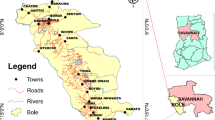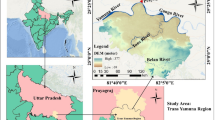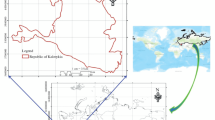Abstract
This study analyzed Groundwater Productivity Potential (GPP) using different models in a geographic information system (GIS) in Okcheon area, Korea. These models used the relationship between groundwater-productivity data, including specific capacity (SPC) and transmissivity (T), and its related hydrogeological factors. Data about related factors, including topography, lineament, geology, forest and soil were constructed to a spatial database. Additionally, T and SPC data were collected from 86 well locations. Then, GPP were mapped using the Logistic Regression (LR) and Boosted Tree Regression (BT) models. The resulting GPP maps were validated using Area Under Curve (AUC) analysis with the well data. The GPP maps using the LR and BT models had accuracies of 85.04 and 81.66% with T value, respectively. And the GPP maps using the LR and BT models had accuracies of 82.22 and 81.53% with SPC value, respectively. These results indicate that LR and BT models can be useful for GPP mapping.
Access this chapter
Tax calculation will be finalised at checkout
Purchases are for personal use only
Similar content being viewed by others
References
Jothibasu, A., Anbazhagan, S.: Spatial mapping of groundwater potential in Ponnaiyar River basin using probabilistic-based frequency ratio model. Model. Earth Syst. Environ. 3(1), 33 (2017)
Lee, S., Hong, S.-M., & Jung, H.-S.: GIS-based groundwater potential mapping using artificial neural network and support vector machine models: the case of Boryeong city in Korea. Geocarto. Int., 1–15 (2017)
Rahmati, O., Pourghasemi, H.R., Melesse, A.M.: Application of GIS-based data driven random forest and maximum entropy models for groundwater potential mapping: a case study at Mehran Region, Iran. Catena 137, 360–372 (2016)
Park, S., Hamm, S.-Y., Jeon, H.-T., Kim, J.: Evaluation of logistic regression and multivariate adaptive regression spline models for groundwater potential mapping using R and GIS. Sustainability 9(7), 1157 (2017)
Mousavi, S.M., Golkarian, A., Naghibi, S.A., Kalantar, B., Pradhan, B.: GIS-based groundwater spring potential mapping using data mining boosted regression tree and probabilistic frequency ratio models in Iran. AIMS Geosci. 3(1), 91–115 (2017)
Author information
Authors and Affiliations
Corresponding author
Editor information
Editors and Affiliations
Rights and permissions
Copyright information
© 2019 Springer Nature Switzerland AG
About this paper
Cite this paper
Lee, S., Lee, CW., Kim, JC. (2019). Groundwater Productivity Potential Mapping Using Logistic Regression and Boosted Tree Models: The Case of Okcheon City in Korea. In: El-Askary, H., Lee, S., Heggy, E., Pradhan, B. (eds) Advances in Remote Sensing and Geo Informatics Applications. CAJG 2018. Advances in Science, Technology & Innovation. Springer, Cham. https://doi.org/10.1007/978-3-030-01440-7_69
Download citation
DOI: https://doi.org/10.1007/978-3-030-01440-7_69
Published:
Publisher Name: Springer, Cham
Print ISBN: 978-3-030-01439-1
Online ISBN: 978-3-030-01440-7
eBook Packages: Earth and Environmental ScienceEarth and Environmental Science (R0)




